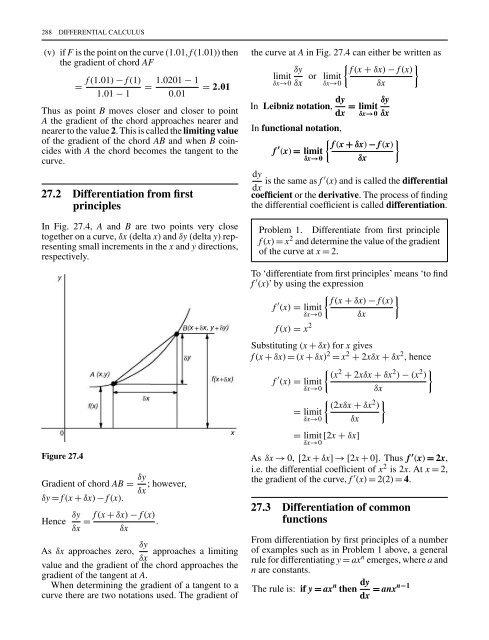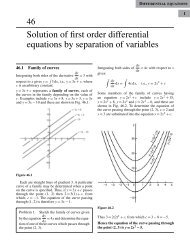differentiation
Create successful ePaper yourself
Turn your PDF publications into a flip-book with our unique Google optimized e-Paper software.
288 DIFFERENTIAL CALCULUS<br />
(v) if F is the point on the curve (1.01, f (1.01)) then<br />
the gradient of chord AF<br />
=<br />
f (1.01) − f (1)<br />
1.01 − 1<br />
= 1.0201 − 1<br />
0.01<br />
= 2.01<br />
Thus as point B moves closer and closer to point<br />
A the gradient of the chord approaches nearer and<br />
nearer to the value 2. This is called the limiting value<br />
of the gradient of the chord AB and when B coincides<br />
with A the chord becomes the tangent to the<br />
curve.<br />
27.2 Differentiation from first<br />
principles<br />
In Fig. 27.4, A and B are two points very close<br />
together on a curve, δx (delta x) and δy (delta y) representing<br />
small increments in the x and y directions,<br />
respectively.<br />
Figure 27.4<br />
Gradient of chord AB = δy<br />
δx ; however,<br />
δy = f (x + δx) − f (x).<br />
Hence δy<br />
δx<br />
f (x + δx) − f (x)<br />
= .<br />
δx<br />
δy<br />
As δx approaches zero, approaches a limiting<br />
δx<br />
value and the gradient of the chord approaches the<br />
gradient of the tangent at A.<br />
When determining the gradient of a tangent to a<br />
curve there are two notations used. The gradient of<br />
the curve at A in Fig. 27.4 can either be written as<br />
{ }<br />
δy f (x + δx) − f (x)<br />
limit or limit<br />
δx→0 δx δx→0 δx<br />
In Leibniz notation, dy<br />
dx = limit δy<br />
δx→0 δx<br />
In functional notation,<br />
f ′ (x) = limit<br />
δx→0<br />
{ }<br />
f (x + δx) − f (x)<br />
dy<br />
dx is the same as f ′ (x) and is called the differential<br />
coefficient or the derivative. The process of finding<br />
the differential coefficient is called <strong>differentiation</strong>.<br />
Problem 1. Differentiate from first principle<br />
f (x) = x 2 and determine the value of the gradient<br />
of the curve at x = 2.<br />
To ‘differentiate from first principles’ means ‘to find<br />
f ′ (x)’ by using the expression<br />
{ }<br />
f (x + δx) − f (x)<br />
f ′ (x) = limit<br />
δx→0 δx<br />
f (x) = x 2<br />
Substituting (x + δx) for x gives<br />
f (x + δx) = (x + δx) 2 = x 2 + 2xδx + δx 2 , hence<br />
{ (x<br />
f ′ 2 + 2xδx + δx 2 ) − (x 2 }<br />
)<br />
(x) = limit<br />
δx→0<br />
δx<br />
{ (2xδx + δx 2 }<br />
)<br />
= limit<br />
δx→0 δx<br />
= limit [2x + δx]<br />
δx→0<br />
As δx → 0, [2x + δx] → [2x + 0]. Thus f ′ (x) = 2x,<br />
i.e. the differential coefficient of x 2 is 2x.Atx = 2,<br />
the gradient of the curve, f ′ (x) = 2(2) = 4.<br />
δx<br />
27.3 Differentiation of common<br />
functions<br />
From <strong>differentiation</strong> by first principles of a number<br />
of examples such as in Problem 1 above, a general<br />
rule for differentiating y = ax n emerges, where a and<br />
n are constants.<br />
The rule is: if y = ax n then dy<br />
dx = anxn−1










